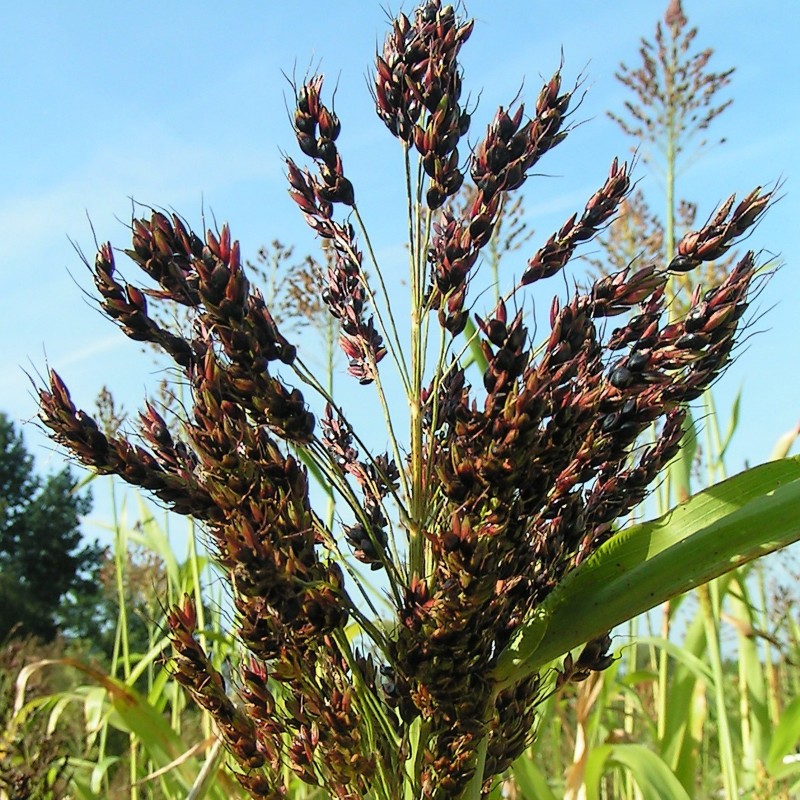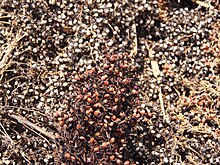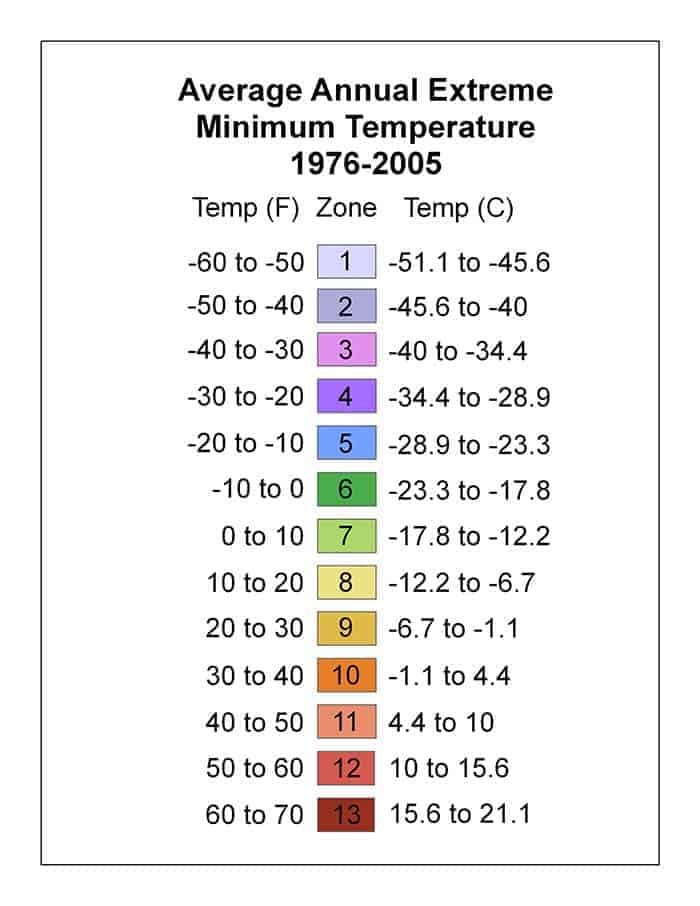
Coming Soon






Sorghum bicolor, commonly called sorghum (/ˈsɔːrɡəm/) and also known as great millet, durra, jowari, or milo, is a grass species cultivated for its grain, which is used
Sorghum bicolor, commonly called sorghum (/ˈsɔːrɡəm/) and also known as great millet, durra, jowari, or milo, is a grass species cultivated for its grain, which is used for food for humans, animal feed, and ethanol production. Sorghum originated in Africa, and is now cultivated widely in tropical and subtropical regions.[4] Sorghum is the world's fifth-most important cereal crop after rice, wheat, maize, and barley. S. bicolor is typically an annual, but some cultivars are perennial. It grows in clumps that may reach over 4 m high. The grain is small, ranging from 2 to 4 mm in diameter. Sweet sorghums are sorghum cultivars that are primarily grown for forage, syrup production, and ethanol; they are taller than those grown for grain.
S. bicolor is the cultivated species of sorghum; its wild relatives make up the botanical genus Sorghum.


The leading producers of S. bicolor in 2011 were Nigeria (12.6%), India (11.2%), Mexico (11.2%), and the United States (10.0%).[7] Sorghum grows in a wide range of temperatures, high altitudes, and toxic soils, and can recover growth after some drought.[5] It has five features that make it one of the most drought-resistant crops:
Richard Pankhurst reports (citing Augustus B. Wylde) that in 19th-century Ethiopia, durra was "often the first crop sown on newly cultivated land", explaining that this cereal did not require the thorough ploughing other crops did, and its roots not only decomposed into a good fertilizer, but they also helped to break up the soil while not exhausting the subsoil.

Sorghum is cultivated in many parts of the world today. In the past 50 years, the area planted with sorghum worldwide had increased by 66%.. The grain finds use as food, for making liquor, animal feed, or making bio based ethanol.
In many parts of Asia and Africa, its grain is used to make flatbreads that form the staple food of many cultures. The grains can also be popped in a similar fashion to popcorn.
| Nutritional value per 100 g (3.5 oz) | |
|---|---|
| Energy | 1,418 kJ (339 kcal) |
|
Carbohydrates
|
74.63 g
|
| Dietary fiber | 6.3 g |
|
Fat
|
3.30 g
|
|
Protein
|
11.30 g
|
|
|
| †Percentages are roughly approximated using US recommendations for adults. | |
Sorghum is one of a number of grains used as wheat substitutes in gluten-free recipes and products.
In India, where it is commonly called jwaarie, jowar, jola, or jondhalaa, sorghum is one of the staple sources of nutrition. An Indian bread called bhakri, jowar roti, or jolada rotti is prepared from this grain.
In Korea, it is cooked with rice, or its flour is used to make cake called susu bukkumi.
Sorghum was ground and the flour was the main alternative to wheat in northern China for a long time.
In Central America, tortillas are sometimes made using sorghum. Although corn is the preferred grain for making tortillas, sorghum is widely used and is well accepted in Honduras. White sorghum is preferred for making tortillas.[11] Sweet sorghum syrup is known as molasses in some parts of the U.S., although it is not true molasses.
In China, sorghum is known as gaoliang (高粱), and is fermented and distilled to produce one form of clear spirits known as baijiu (白酒) of which the most famous is Maotai (or Moutai). In Taiwan, on the island called Kinmen, plain sorghum is made into sorghum liquor.In several countries in Africa, including Zimbabwe, Burundi, Mali, Burkina Faso, Ghana, and Nigeria, sorghum of both the red and white varieties is used to make traditional opaque beer. Red sorghum imparts a pinkish-brown colour to the beer.[12]
In Australia, South America, and the United States, sorghum grain is used primarily for livestock feed and in a growing number of ethanol plants.[13] In some countries, sweet sorghum stalks are used for producing biofuel by squeezing the juice and then fermenting it into ethanol.[14] Texas A&M University in the United States is currently running trials to find the best varieties for ethanol production from sorghum leaves and stalks in the USA.[15]
It is also used for making a traditional corn broom.[16]The reclaimed stalks of the sorghum plant are used to make a decorative millwork material marketed as Kirei board.
It is used in feed and pasturage for livestock. Its use is limited, however, because the starch and protein in sorghum is more difficult for animals to digest than the starches and protein in corn.[citation needed] Research is being done to find a process that will predigest the grain. One study on cattle showed that steam-flaked sorghum was preferable to dry-rolled sorghum because it improved daily weight gain.[7] In hogs, sorghum has been shown to be a more efficient feed choice than corn when both grains were processed in the same way.[7]
The introduction of improved varieties, along with improved management practices, has helped to increase sorghum productivity. In India, productivity increases are thought to have freed up six million hectares of land. The International Crops Research Institute for the Semi-Arid Tropics in collaboration with partners produces improved varieties of crops including sorghum. Some 194 improved cultivars of sorghum from the institute have been released.[17]
Research is being conducted to develop a genetic cross that will make the plant more tolerant to colder temperatures and to unravel the drought tolerance mechanisms, since it is native to tropical climates.[18][19] In the United States, this is important because the cost of corn was steadily increasing due to its use in ethanol production for addition to gasoline. Sorghum silage can be used as a replacement of corn silage in the diet for dairy cattle.[20] More research has found that sorghum has higher nutritional value compared to corn when feeding dairy cattle, and the type of processing is also essential in harvesting the grain's maximum nutrition. Feeding steam-flaked sorghum showed an increase in milk production when compared to dry-rolling.[20]
Additional research is being done on sorghum as a potential food source to meet the increasing global food demand. Sorghum is resistant to drought- and heat-related stress. The genetic diversity between subspecies of sorghum makes it more resistant to pests and pathogens than other less diverse food sources. In addition, it is highly efficient in converting solar energy to chemical energy, and also in use of water.[21] All of these characteristics make it a promising candidate to help meet the increasing global food demand. As such, many groups around the world are pursuing research initiatives around sorghum (specifically Sorghum bicolor): Purdue University,[22]HudsonAlpha Institute for Biotechnology,[21] Danforth Plant Science Center,[21] the University of Nebraska,[23] and the University of Queensland [24] among others. The University of Queensland is involved with pre-breeding activities, which are extremely successful and still are in progress using crop wild relatives as donors along with popular varieties as recipients to make sorghum more resistant to biotic stresses.
Another research application of sorghum is as a biofuel. Sweet sorghum has a high sugar content in its stalk, which can be turned into ethanol. The biomass can be burned and turned into charcoal, syn-gas, and bio-oil.

 Reviews (0)
Reviews (0)